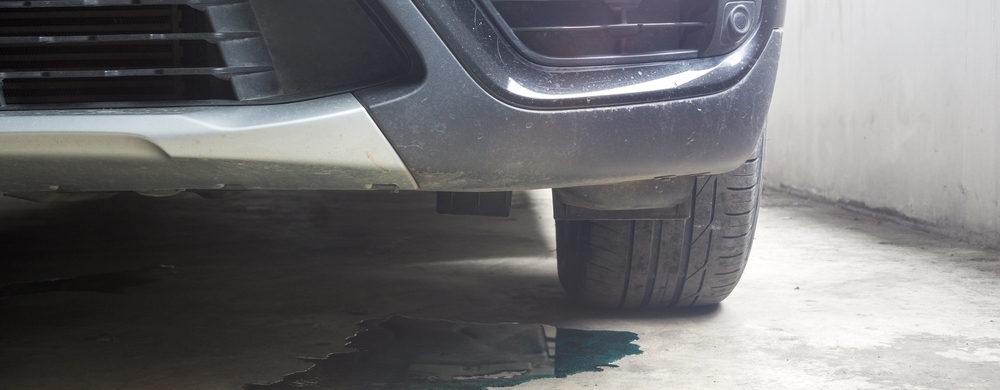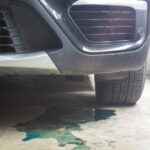
31 Mar How Can You Identify Auto Fluid Leaks? Helpful Tips
 Do you struggle to figure out what the spots of leaking fluid are under your car? I mean, does what it is really matter? The short answer is yes. These helpful tips will help you identify the auto fluid leaks under your car, whether it is leaking brake fluid, coolant, or gasoline. Because leaving those fluid leaks unaddressed can lead to expensive repairs, damages, and health issues.
Do you struggle to figure out what the spots of leaking fluid are under your car? I mean, does what it is really matter? The short answer is yes. These helpful tips will help you identify the auto fluid leaks under your car, whether it is leaking brake fluid, coolant, or gasoline. Because leaving those fluid leaks unaddressed can lead to expensive repairs, damages, and health issues.
Is Identifying Auto Fluid Leaks Important?
While leaking fluids may not seem like a big deal, you should take it seriously. Your vehicle’s performance and safety can suffer when auto fluids get low. Auto fluid leaks can signal your car require maintenance or repairs. Plus, most automotive fluids are not human or environment-friendly. They can lead to health concerns and fines for non-compliance with PA state inspection guidelines. Considering all of these factors, it’s in your best interest to monitor the ground under your car for any signs of leaking fluids.
Choose Your Method
You can use several methods to figure out what type of fluid is pooling under your car. Most automotive fluids differ in color, feel, and smell. While using a single method may identify your leaking fluid right off the bat, you can use each way to narrow down the cause. Let’s break it down by each method.
Auto Fluid Leaks: By Color
Most automotive fluids come in different colors to help you determine what it is at a glance. However, this isn’t always as black and white as it sounds. Different auto manufacturers can use different colored fluids for various makes and models. Let’s review the most common variations. If you have questions about your specific vehicle, read your owner’s manual for more details.
- Amber, Dirty Grey, Muddy Brown: Engine oil appears honey-colored when fresh but turns shades of dirty grey or brown as it ages. It feels slippery, thick, and maybe even slightly gritty if an oil change is overdue.
- Black: Very dark or black spots under your car can be engine oil, differential fluid, or grease from your suspension.
- Blue: Blue fluid leaks can be a brand-specific coolant formula or window washing fluid.
- Clear (colorless): Most likely condensation or water droplets. It usually dries quickly and leaves no mark behind.
- Clear (colorless) to dirty-clear: Power-steering fluid often starts out colorless and looks ‘dirty’ as it ages. It feels oily and slightly slippery. Not to be confused with ATF*.
- Green, Blue, Teal (sometimes, Yellow or Purple): ATF* fluid used in some power-steering systems starts off as these sheer colors when new and gradually changes into amber, then to dirty brown as it ages. It feels oily and slightly slippery.
- Purple: Purple fluid leaks can be a brand-specific coolant formula, DOT5 brake fluid, or window washing fluid.
- Rainbow: Rainbow sheen often appears on wet pavement or floating on puddles of water under or near your car. These pretty rainbows indicate a petroleum-based residue (like gasoline).
- Red, Pink, Golden-Amber, Darkest Brown: Transmission fluid starts out as a sheer red or deep pink and gradually changes to gold and brown as it ages. It feels very slippery and thin between your fingers.
- Sheer Red, Pink, Amber, Dirty-Brown: ATF* fluid used in some power-steering systems starts off as sheer red when new and gradually changes into amber, then to dirty brown as it ages. It feels oily and slightly slippery.
- Yellow, Blue, Red, or Green shades: DOT3 & DOT4 brake fluid can start as any of these colors but darken to dirty brown as they age.
- Yellow-Green, Orange, Pink, Red, Green, Purple, Blue (Translucent, bright, or neon shades): Coolant can come in a wide variety of shades, but they all should be translucent or see-through and are often very bright or neon-colored. When rubbed between your fingers, the fluid feels semi-slick, thin, and watery.
Auto Fluid Leaks: By Smell
Identifying leaking fluids by smell can be difficult for some people, as smells are inherently subjective. Below, I have highlighted some easily identifiable smells associated with common auto fluids.
- Burned Cooking Oil: You know that smell when the oil in your frying pan is too hot? That’s kinda what engine oil smells like, with maybe a bit more chemical odor to it.
- Burnt Marshmallows: When s’mores go horribly wrong, and the marshmallow on your stick burns to a blackened lump – yup, that’s sort of what power-steering fluid smells like.
- Gasoline: If it smells like gasoline, then it probably is. The chemical smell is the same odor you notice at the gas station when filling your tank.
- Fishy-Chemical: Brake fluid can have a slightly fishy-chemical smell that’s mildly unpleasant.
- Petroleum: Transmission fluids smell strongly of petroleum, tar, or oil-based chemicals.
- Sweet, Candy-like: Antifreeze smells sweet, almost like candy or a fruity soda. It smells good enough to eat, but DON’T taste it. Antifreeze or coolant is toxic to humans and animals. Be sure to clean up the leaking coolant, as it’s quite hazardous.
- Unscented: Fluids without an odor may be condensation or melting snow or ice. Most automotive fluids have a scent.
- WindexTM Glass Cleaner: Windshield washer fluid smells a lot like the stuff you use to clean your household windows and mirrors.
Auto Fluid Leaks: By Location
Where the auto fluid leak occurs can really help you pinpoint which fluid is leaking. Of course, remember that different vehicle makes and models may have slightly different locations for automotive components. When in doubt, consult your owner’s manual for specific information on your car. Let’s look at some common culprits.
Vehicle Front
- Coolant: The radiator, hoses, and reservoir tank are all located towards the front of most vehicles. If you suspect leaking coolant by the color and smell, see if you can track the leak to its source at the front of your car.
- Engine Oil: These leaks are usually more like drips or spots under your vehicle and can vary in location. Leaking engine oil tends to spread out across components and then drip to the ground far from the source of the leak. Check the oil level with the dipstick if you suspect an engine oil leak. Low levels may require a diagnostic service to locate which gasket, seal, hose, or oil pan is the cause.
- Power-steering Fluid: Power steering fluid leaks from the reservoir, pump, hoses, or gears (rack and pinion), which may all be towards the vehicle’s front end.
- Windshield Washer Fluid: On most modern vehicles, you can find the windshield washer reservoir under the hood near the fender or behind the wheel well cover.
Vehicle Middle
- Condensation: Clear liquid found under the passenger seating area may be from the A/C.
- Transmission Fluid: Leaks occur from the transmission oil pan, near the axles, or from hoses or lines from the transmission near the front to the middle of your vehicle.
Vehicle Rear
- Brake Fluid: Leaking brake fluid under a tire is usually a sign of a damaged brake line, brake caliper, or wheel cylinder.
- Differential Gear Oil: The differential gear can create an oily-feeling leak towards the vehicle’s rear.
- Gasoline: If you smell gas near your car, look at the ground under the rear end where you fill up your gas tank. Leaking gasoline will rarely leave a puddle because it evaporates quickly. However, you may see a clean line or two running down the outside of your fuel tank or around the gas cap. These are signs of a gasoline leak.
Auto Fluid Leaks Service In Plymouth Meeting, PA
Find quality auto repair at Plymouth Auto & Tire Center in Plymouth Meeting, PA. Our skilled and caring team of mechanics can help! We can quickly locate the source of leaking brake fluid, coolant, and gasoline and do the repairs efficiently.
Make An Appointment
Call us at (610) 825-6558 or visit us online to make an appointment for your auto fluid leaks diagnostic appointment now.

